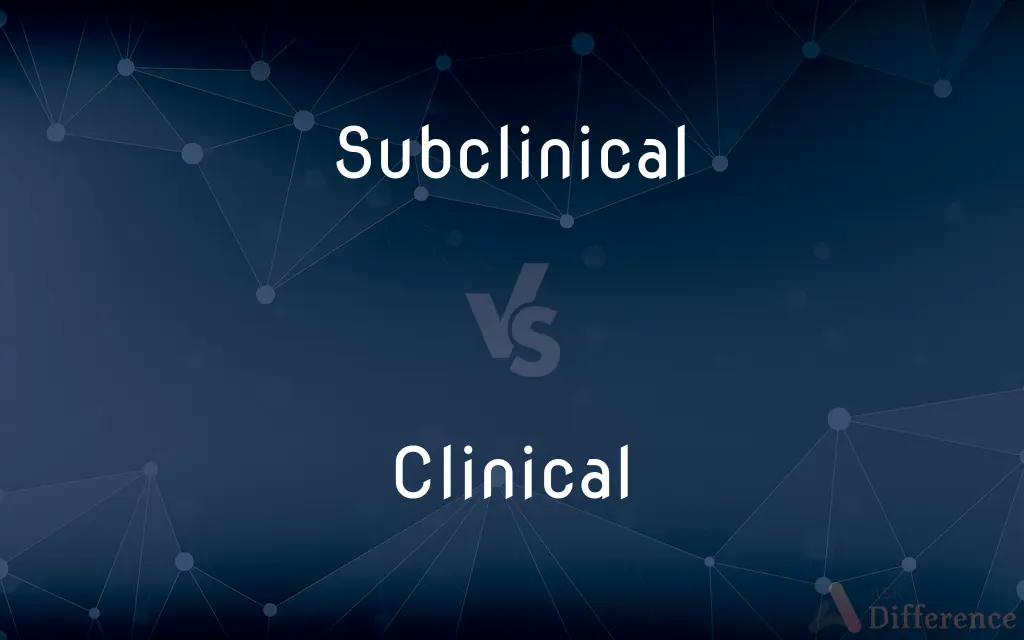Subclinical vs. Clinical — What's the Difference?
By Urooj Arif & Maham Liaqat — Updated on March 24, 2024
Subclinical conditions lack noticeable symptoms, while clinical conditions present clear, identifiable symptoms.

Difference Between Subclinical and Clinical
Table of Contents
ADVERTISEMENT
Key Differences
Subclinical conditions are those that exist below the threshold of clinical detection, meaning they do not produce noticeable symptoms or signs that are easily identifiable. These conditions can be in an early stage or a mild form that doesn't significantly impact normal function or require medical treatment. Clinical conditions, on the other hand, have clear and identifiable symptoms or signs that can be observed and diagnosed by healthcare professionals.
In the context of diseases, a subclinical disease may be in an incubation period or could be a chronic condition that remains undetected due to the absence of clear symptoms. Clinical diseases are characterized by symptoms and signs that are evident enough to lead to a diagnosis, often prompting the need for treatment or intervention.
For diagnostics, subclinical conditions might only be identified through routine screenings or tests that reveal abnormalities not yet manifesting as symptoms. Clinical conditions typically prompt diagnostic testing due to the presence of symptoms, leading to a more straightforward diagnosis.
The management and treatment of subclinical conditions can be challenging due to the lack of overt symptoms, and often, these conditions are monitored for changes that could necessitate intervention. In contrast, clinical conditions, because of their evident symptoms, usually receive more immediate and targeted treatment.
Understanding the difference between subclinical and clinical conditions is crucial for preventive healthcare, as it can guide strategies for early detection and intervention before conditions progress to a more severe or symptomatic stage.
ADVERTISEMENT
Comparison Chart
Symptom Presentation
Lacks noticeable symptoms.
Presents clear, identifiable symptoms.
Detection
Through screenings or incidental findings.
Prompted by symptom presentation.
Disease Stage
Early or mild stage, often unnoticed.
More advanced, requiring intervention.
Management
Monitoring, may not require immediate treatment.
Immediate and targeted treatment.
Importance in Healthcare
Crucial for early detection and prevention.
Key for diagnosis and treatment planning.
Compare with Definitions
Subclinical
Not manifesting noticeable symptoms or signs.
Subclinical thyroid disorders can go unnoticed without specific tests.
Clinical
Characterized by symptoms and signs that can be observed and diagnosed.
Clinical depression presents with observable symptoms such as persistent sadness.
Subclinical
May be detected incidentally during routine health screenings.
A subclinical infection was found during a routine blood test.
Clinical
Management is targeted towards symptom relief and addressing underlying causes.
Clinical management of asthma involves relieving symptoms and reducing inflammation.
Subclinical
Can exist without ever progressing to a clinical condition.
Some subclinical infections resolve without ever causing symptoms.
Clinical
Can be the progression from a subclinical stage.
Subclinical hypothyroidism can develop into clinical hypothyroidism if left untreated.
Subclinical
Often precedes the clinical phase of a disease.
Subclinical inflammation may precede noticeable arthritis symptoms.
Clinical
Requires medical evaluation and often treatment.
Clinical hypertension necessitates intervention to prevent complications.
Subclinical
Important for preventive health measures.
Identifying subclinical atherosclerosis can prevent future cardiovascular events.
Clinical
Diagnosis is often straightforward due to symptom presence.
The clinical presentation of chickenpox includes a characteristic rash.
Subclinical
Not manifesting characteristic clinical symptoms. Used of a disease or condition.
Clinical
Relating to the observation and treatment of actual patients rather than theoretical or laboratory studies
Clinical medicine
Clinical drug trials
Subclinical
Of a disease or injury, without signs and symptoms that are detectable by physical examination or laboratory test; not clinically manifest.
Clinical
Very efficient and without feeling; coldly detached
Nothing was left to chance—everything was clinical
Subclinical
In diagnosis, where some criteria are met but not enough to achieve clinical status
Clinical
Of, relating to, or connected with a clinic.
Subclinical
Less than is needed for clinical reasons
Clinical
Involving or based on direct observation of a patient
A clinical diagnosis.
Clinical research.
Subclinical
Relating to the stage in the development of a disease before the symptoms are observed
Clinical
Objective and devoid of emotion; coolly analytical
"He spoke in the clipped, clinical monotones typical of police testimony in court" (Connie Paige).
Clinical
Suggestive of a medical clinic; austere and antiseptic
A clinical style of decor.
Clinical
(medicine) Dealing with the practical management of patients, in practice#Noun at the point of care; as contrasted with other health care venues (see clinical medicine#Noun for more explanation).
Clinical
Of or pertaining to a clinic, such as a medical clinic or law clinic.
Medicine is now more often practiced in a clinical setting than in the home.
Clinical
Cool and emotionless; in a professional way, as contrasted with an impetuous#Adjective or unprofessional#Adjective way.
Clinical
Objective; analytical.
We took a clinical approach to resolving conflicts.
Clinical
Precise.
Clinical
(obsolete) Of or relating to a bed, especially a deathbed.
A clinical convert: one who turns to religion on their death-bed
Clinical baptism
Clinical
(education) A medical student's session spent in a real-world nursing environment.
Clinical
Of or pertaining to a bed, especially, a sick bed.
Clinical
Of or pertaining to a clinic, or to the study of disease in the living subject.
Clinical
Relating to a clinic or conducted in or as if in a clinic and depending on direct observation of patients;
Clinical observation
Clinical case study
Clinical
Scientifically detached; unemotional;
He spoke in the clipped clinical monotones typical of police testimony
Common Curiosities
Why are subclinical conditions important in healthcare?
Subclinical conditions are important because their early detection can prevent progression to more serious, symptomatic stages.
What role do screenings play in detecting subclinical conditions?
Screenings are crucial for detecting subclinical conditions, often identifying potential health issues before symptoms arise.
Can a subclinical condition become clinical?
Yes, subclinical conditions can progress to clinical stages if they worsen or start to produce symptoms.
Can lifestyle changes affect subclinical conditions?
Yes, lifestyle changes can positively impact subclinical conditions, potentially preventing their progression to clinical stages.
What is the significance of asymptomatic conditions in epidemiology?
Asymptomatic or subclinical conditions can play a significant role in the spread of diseases, as individuals may unknowingly transmit infections.
How can subclinical conditions be monitored?
Subclinical conditions are often monitored through regular check-ups and tests to track any changes or progression.
What makes a condition 'clinical'?
A condition is considered 'clinical' when it presents symptoms or signs that can be observed, diagnosed, and treated.
Can subclinical conditions cause complications?
Although less likely than clinical conditions, subclinical conditions can sometimes lead to complications if they progress or affect body functions.
What is a subclinical infection?
A subclinical infection is one that doesn't cause noticeable symptoms, making it difficult to detect without specific tests.
How can a clinical condition be identified?
Clinical conditions are identified through medical evaluation based on the presence of symptoms and signs.
Are all subclinical conditions detectable through screenings?
While many subclinical conditions can be detected through screenings, some may remain undetected without specific targeted tests.
Is treatment always necessary for clinical conditions?
While clinical conditions generally require intervention, the extent and nature of treatment can vary based on the condition's severity and impact.
How are clinical conditions diagnosed?
Clinical conditions are diagnosed through a combination of symptom assessment, physical examinations, and diagnostic tests.
What preventive measures can be taken for subclinical conditions?
Preventive measures include regular screenings, healthy lifestyle choices, and addressing risk factors to prevent progression.
How is the transition from subclinical to clinical managed in healthcare?
The transition from subclinical to clinical is managed by monitoring for symptom development and initiating treatment as necessary to prevent complications.
Share Your Discovery

Previous Comparison
Sulfamic vs. Sulfuric
Next Comparison
Harbour vs. QuayAuthor Spotlight
Written by
Urooj ArifUrooj is a skilled content writer at Ask Difference, known for her exceptional ability to simplify complex topics into engaging and informative content. With a passion for research and a flair for clear, concise writing, she consistently delivers articles that resonate with our diverse audience.
Co-written by
Maham Liaqat














































